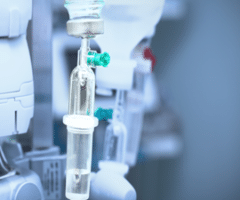
Treatment Options
Chemotherapy

Chemotherapy halts cell growth and division to prevent cancer cells from making more and more cancer cells; however, chemotherapy drugs not only affect the cancer cells but also any normal rapidly dividing cells, which can cause side effects.
The purpose of chemotherapy is to kill cancer cells. It is usually used to treat cancer when it is systemic, meaning that the cancer has spread throughout the body. Lymphoma is caused by uncontrolled growth in one or the other of two types of white blood cells called T cells and B cells. T cells and B cells are important elements of the immune system that can travel through the bloodstream. An advantage of chemotherapy is that it can also travel throughout the bloodstream to kill the cancer cells wherever they may be located.
Many patients who are treated for lymphoma are given combination chemotherapy, which means two or more drugs, instead of single-agent therapy. These chemotherapy drugs are given in a specific order (schedule) during certain days of each treatment cycle—this is called a treatment regimen. The reason for using a combination of drugs is to increase how effectively the drugs kill or damage cancer cells.
Common Chemotherapy Regimens
Many chemotherapy regimens for B-cell NHL include the monoclonal antibody rituximab (Rituxan), which is usually abbreviated with the letter R and placed at the beginning or end of the regimen abbreviation, such as R-CHOP or CHOP-R (cyclophosphamide [Cytoxan], doxorubicin [Adriamycin], vincristine [Oncovin], and prednisone [Deltasone]). Most of these chemotherapy drugs have been in use for decades, but several have been developed more recently. Bendamustine (Treanda) is a newer alkylating agent, a class of drugs that causes damage to a cell’s DNA. Pralatrexate (Folotyn) is a novel antimetabolite, a class of drugs that interferes with normal DNA production by eliminating folate, which is needed for creation of DNA. Since cancer cells divide more rapidly than normal cells, they are more sensitive to DNA damage.
Bendamustine is approved for the treatment of chronic lymphocytic leukemia (CLL) and also approved for the treatment of indolent B-cell NHL that has progressed during or within six months of treatment with rituximab or a rituximab-containing regimen. Pralatrexate is approved for the treatment of patients with peripheral T-cell lymphoma that has progressed after prior treatment. In addition, brentuximab vedotin (Adcetris) is a type of antibody-drug conjugate that is a treatment for HL and anaplastic large cell lymphoma. An antibody-drug conjugate is a monoclonal antibody that is linked to a toxin, in this case a chemotherapy agent called monomethyl auristatin E (MMAE). Brentuximab vedotin targets CD30 found on the cells of some forms of lymphoma and delivers the chemotherapy drug that kills the cancer cell. Each of these drugs is also being investigated for other uses.
During chemotherapy, patients receive the drug or drugs orally (pill taken by mouth) or intravenously (IV; injection directly into the vein), one or more times a week for one or more weeks, followed by a rest period. This regular treatment schedule is called a cycle. The length of the rest period and the number of cycles vary depending on the particular disease and the type of drug(s) used.
Download the Chemotherapy Fact Sheet
Learn more about chemotherapy in lymphoma and what to expect.